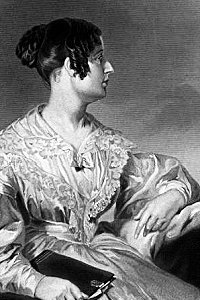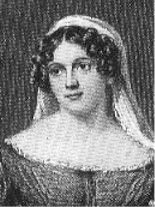Introduction

Born: September 25, 1793, Liverpool, England.
Died: May 16, 1835, Dublin, Ireland.
Buried: St. Ann’s Church, Dawson Street, Dublin, Ireland.


Born: September 25, 1793, Liverpool, England.
Died: May 16, 1835, Dublin, Ireland.
Buried: St. Ann’s Church, Dawson Street, Dublin, Ireland.

In 1800, Felicia’s father having suffered severe business losses, the Hemans family moved to near Abergele, North Wales.
In 1812, Felicia married Captain Hemans, who, on retiring from the army sometime after, moved to Bronnylfa (near St. Asaph).
Some years later, he left his wife and children and went to Italy, where he died.
In 1828, Felicia moved to Wavertree, near Liverpool, and in 1831 to Dublin.
The breaking waves dashed high,
On a stern and rockbound coast,
And the woods against a stormy sky,
Their giant branches tossed,
And the heavy night hunk dark,
The hills and waters o’er,
When a band of exiles moored their bark
On the wild New England Shore.
Not as the conqueror comes,
They, the true-hearted, came;
Not with the roll of stirring drums,
And the trumpet that sings of fame;
Not as the flying come,
In silence and in fear—
They shook the depths of the desert’s gloom
With their hymns of lofty cheer.
Amidst the storm they sang,
And the stars heard and the sea!
And the sounding aisles of the dim woods
Rang to the anthem of the free!
The ocean eagle soared from his nest
By the white waves’ foam,
And the rocking pines of the forest roared—
This was their welcome home!
There were men with hoary hair
Amidst that pilgrim band—
Why had they come to wither there,
Away from their childhood’s land?
There was woman’s fearless eye,
Lit by her deep love’s truth;
There was manhood’s brow, serenely high,
And the fiery heart of youth.
What sought they thus afar?
Bright jewels of the mine?
The wealth of seas? the spoils of war?
They sought a faith’s pure shrine!
Ay, call it holy ground,
The soil where first they trod;
They left unstained what there they found—
Freedom to worship God.
Felicia Dorothea Browne Hemans, 1828
Sitting at the tea-table one evening, near a century ago, Mrs. Hemans read an old account of the
Landing of the Pilgrims,and was inspired to write this poem, which became a favorite in America—like herself, and all her other works.The ballad is inaccurate in details, but presents the spirit of the scene with true spirit insight. Mr. James T. Fields, the noted Boston publisher, visited the lady in her old age, and received an autograph copy of the poem, which is seen in Pilgrim Hall, Plymouth, Mass.
Brown, p. 323
I hear thee speak of the better land,
Thou callest its children a happy band;
Mother! oh where is that radiant shore?
Shall we not seek it, and weep no more?
Is it where the flower of the orange blows,
And the fire-flies glance through the myrtle boughs?—
Not there, not there, my child!
Is it where the feathery palm-trees rise,
And the date grows ripe under sunny skies?
Or ’midst the green islands of glittering seas,
Where fragrant forests perfume the breeze,
And strange, bright birds, on their starry wings,
Bear the rich hues of all glorious things?
—Not there, not there, my child!
Is it far away, in some region old,
Where the rivers wander o’er sands of gold?
Where the burning rays of the ruby shine,
And the diamond lights up the secret mine,
And the pearl gleams forth from the coral strand?
Is it there, sweet mother, that better land?
—Not there, not there, my child!
Eye hath not seen it, my gentle boy!
Ear hath not heard its deep songs of joy;
Dreams can not picture a world so fair—
Sorrow and death may not enter there;
Time doth not breathe on its fadeless bloom,
For beyond the clouds, and beyond the tomb,
—It is there, it is there, my child!
Felicia Dorothea Browne Hemans (1793–1835)